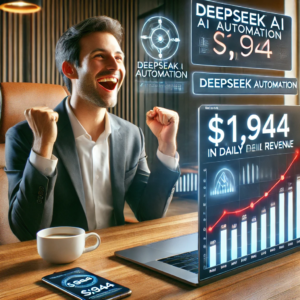Top 10 AI Forecasting Tools for Accurate Market Analysis
Revolutionizing Business Predictions with Advanced Technology
In today’s rapidly evolving business landscape, AI forecasting tools have become indispensable for companies seeking to gain a competitive edge in market analysis.
These sophisticated technologies leverage artificial intelligence and machine learning algorithms to process vast amounts of data and generate accurate predictions.
By harnessing the power of AI forecasting tools, businesses can make informed decisions, optimize their strategies, and stay ahead of market trends.
In this comprehensive guide, we’ll explore the top 10 AI forecasting tools that are revolutionizing market analysis and helping organizations achieve unprecedented levels of accuracy in their predictions.
We’ll delve into the unique features, benefits, and applications of each tool, providing you with valuable insights to enhance your forecasting capabilities.
Whether you’re a small startup or a large enterprise, these AI forecasting tools can significantly improve your decision-making process and drive business growth.
So, let’s dive in and discover how these cutting-edge technologies are transforming the way we approach market analysis and business forecasting.
We strongly recommend that you check out our guide on how to take advantage of AI in today’s passive income economy.
Table of Contents
The Power of AI in Market Forecasting
Before we explore the top AI forecasting tools, it’s essential to understand the transformative impact of artificial intelligence on market analysis.
AI-powered forecasting tools have revolutionized the way businesses predict market trends, consumer behavior, and economic fluctuations.
These advanced systems can process and analyze massive datasets in real-time, identifying patterns and correlations that human analysts might overlook.
By leveraging machine learning algorithms, AI forecasting tools continuously improve their accuracy over time, adapting to new data and market conditions.
This dynamic approach to forecasting enables businesses to make more informed decisions, reduce risks, and capitalize on emerging opportunities.
Furthermore, AI forecasting tools can integrate data from multiple sources, including internal company data, market research, social media trends, and economic indicators.
This comprehensive approach provides a holistic view of the market landscape, allowing for more nuanced and accurate predictions.
As we explore the top 10 AI forecasting tools, keep in mind the transformative potential of these technologies for your business’s market analysis capabilities.
1. Tableau
Tableau stands out as one of the leading AI forecasting tools in the market, offering a powerful combination of data visualization and predictive analytics.
This versatile platform enables users to create interactive dashboards and reports, making it easier to communicate complex forecasts to stakeholders.
Tableau’s AI-driven forecasting capabilities leverage machine learning algorithms to analyze historical data and generate accurate predictions for future trends.
The tool’s intuitive interface allows users to explore different scenarios and adjust variables to see how they impact forecasts in real-time.
One of Tableau’s key strengths is its ability to integrate with a wide range of data sources, including databases, spreadsheets, and cloud services.
This seamless data integration ensures that your forecasts are based on the most up-to-date and comprehensive information available.
Tableau also offers advanced features such as time series decomposition and anomaly detection, which help identify underlying patterns and potential outliers in your data.
For businesses looking to enhance their market analysis with powerful AI forecasting tools, Tableau provides a robust and user-friendly solution.
2. IBM Planning Analytics
IBM Planning Analytics is a comprehensive AI forecasting tool that combines advanced analytics with powerful planning and budgeting capabilities.
This enterprise-level solution leverages IBM’s Watson AI technology to deliver accurate and actionable insights for market analysis and business forecasting.
One of the standout features of IBM Planning Analytics is its ability to perform multi-dimensional analysis, allowing users to explore data from various angles.
This flexibility enables businesses to uncover hidden trends and relationships that may impact their market forecasts and strategic decisions.
The tool’s AI-driven predictive modeling capabilities can automatically identify key drivers and generate forecasts based on historical data and external factors.
IBM Planning Analytics also offers scenario modeling features, allowing users to test different assumptions and evaluate potential outcomes.
With its collaborative planning features, this AI forecasting tool facilitates cross-departmental input and aligns forecasts with overall business objectives.
For organizations seeking a robust and scalable solution, IBM Planning Analytics stands out among AI forecasting tools for its comprehensive approach to market analysis.
3. SAS Forecasting
SAS Forecasting is a powerful AI forecasting tool that combines statistical analysis with machine learning algorithms to deliver highly accurate market predictions.
This advanced platform is designed to handle large-scale forecasting projects, making it ideal for businesses with complex data and multiple product lines.
One of the key strengths of SAS Forecasting is its ability to automatically select the most appropriate forecasting model based on the characteristics of your data.
This feature saves time and ensures that you’re always using the most effective approach for your specific market analysis needs.
SAS Forecasting also offers hierarchical forecasting capabilities, allowing users to generate consistent forecasts across different levels of business hierarchy.
The tool’s interactive visualization features make it easy to explore forecast results and communicate insights to stakeholders throughout the organization.
With its robust data management capabilities and integration with other SAS analytics tools, SAS Forecasting provides a comprehensive solution for market analysis.
For businesses looking for AI forecasting tools that can handle complex forecasting scenarios, SAS Forecasting offers a powerful and flexible option.
4. Google Cloud AI Platform
Google Cloud AI Platform is a versatile suite of AI forecasting tools that leverages Google’s advanced machine learning capabilities for market analysis.
This cloud-based solution offers a range of services, including AutoML Tables for automated model creation and BigQuery ML for SQL-based machine learning.
One of the key advantages of Google Cloud AI Platform is its scalability, allowing businesses to handle massive datasets and complex forecasting tasks with ease.
The platform’s pre-built machine learning models can be quickly deployed for various forecasting applications, from demand prediction to risk assessment.
Google Cloud AI Platform also offers features like Explainable AI, which provides insights into how the AI models arrive at their predictions.
This transparency is crucial for businesses that need to understand and validate the factors influencing their market forecasts.
With its integration with other Google Cloud services, this AI forecasting tool enables seamless data processing, storage, and visualization.
For organizations looking to harness the power of Google’s AI technologies for market analysis, Google Cloud AI Platform provides a comprehensive and innovative solution.
5. Amazon Forecast
Amazon Forecast is a fully managed AI forecasting tool that uses machine learning to deliver highly accurate time-series forecasts.
This powerful service is built on the same technology used by Amazon.com and can be applied to various market analysis scenarios, from demand forecasting to financial planning.
One of the standout features of Amazon Forecast is its ability to automatically handle complex forecasting tasks, such as incorporating seasonality and holiday effects.
The tool can also take into account related data (known as item metadata) to improve forecast accuracy, making it ideal for businesses with diverse product lines.
Amazon Forecast uses a technique called AutoML to automatically evaluate multiple machine learning models and select the best one for your specific dataset.
This approach ensures that you’re always using the most effective forecasting method without requiring extensive data science expertise.
With its pay-per-use pricing model and integration with other AWS services, Amazon Forecast offers a cost-effective and scalable solution for businesses of all sizes.
For companies seeking AI forecasting tools that combine ease of use with advanced capabilities, Amazon Forecast presents a compelling option for market analysis.
6. Prophet
Prophet, developed by Facebook, is an open-source AI forecasting tool that has gained popularity for its ability to produce high-quality forecasts with minimal effort.
This flexible tool is designed to work with time series data and can handle complex seasonality patterns, making it ideal for various market analysis applications.
One of the key strengths of Prophet is its ability to automatically detect and adjust for outliers and missing data, ensuring robust forecasts even with imperfect datasets.
The tool also allows users to incorporate domain knowledge by adding custom seasonality, holidays, and other external factors that may influence forecasts.
Prophet’s user-friendly interface and Python and R libraries make it accessible to data analysts and business users without extensive machine learning expertise.
The tool provides informative visualizations of forecast components, helping users understand the factors driving their predictions and make informed decisions.
With its active open-source community and continuous improvements, Prophet remains at the forefront of AI forecasting tools for market analysis.
For businesses looking for a powerful yet approachable solution, Prophet offers a compelling option among AI forecasting tools.
7. Dataiku DSS
Dataiku Data Science Studio (DSS) is a comprehensive AI forecasting tool that combines data preparation, machine learning, and visualization capabilities.
This end-to-end platform enables businesses to build, deploy, and manage AI-powered forecasting models for various market analysis applications.
One of the key advantages of Dataiku DSS is its collaborative features, which allow data scientists, analysts, and business users to work together seamlessly.
The platform offers a visual interface for data preparation and model building, making it accessible to users with varying levels of technical expertise.
Dataiku DSS supports a wide range of machine learning algorithms and can automatically select the best model for your specific forecasting needs.
The tool also provides robust model governance and version control features, ensuring transparency and reproducibility in your market analysis processes.
With its integration capabilities and scalable architecture, Dataiku DSS can handle complex forecasting projects across large organizations.
For businesses seeking a collaborative and versatile solution among AI forecasting tools, Dataiku DSS offers a powerful platform for advanced market analysis.
8. H2O.ai
H2O.ai is an open-source AI forecasting tool that offers a range of machine learning and predictive analytics capabilities for market analysis.
This powerful platform provides both automated machine learning (AutoML) and customizable model building options, catering to users with different skill levels.
One of the standout features of H2O.ai is its distributed computing architecture, which allows for fast processing of large datasets and complex forecasting tasks.
The platform’s AutoML functionality can automatically train and tune multiple models, selecting the best performer for your specific market analysis needs.
H2O.ai also offers explainable AI features, providing insights into model behavior and helping users understand the factors influencing their forecasts.
With its extensive library of machine learning algorithms and integration with popular programming languages, H2O.ai offers flexibility for advanced users.
The platform’s web-based interface and visualization tools make it easy to explore data, build models, and communicate results to stakeholders.
For organizations looking for a powerful and flexible option among AI forecasting tools, H2O.ai provides a robust solution for sophisticated market analysis.
9. RapidMiner
RapidMiner is a comprehensive data science platform that includes powerful AI forecasting tools for market analysis and predictive modeling.
This user-friendly solution offers a visual workflow designer, allowing users to build complex forecasting models without extensive coding experience.
One of RapidMiner’s key strengths is its extensive library of pre-built operators and machine learning algorithms, covering a wide range of forecasting techniques.
The platform’s Auto Model feature can automatically generate and compare multiple models, helping users quickly identify the best approach for their forecasting needs.
RapidMiner also offers advanced features like automated feature engineering and model optimization, enhancing the accuracy of market predictions.
With its collaborative capabilities and integration with various data sources, RapidMiner facilitates team-based approaches to market analysis and forecasting.
The platform provides detailed model explanations and performance metrics, enabling users to understand and validate their forecasting results.
For businesses seeking a versatile and accessible solution among AI forecasting tools, RapidMiner offers a powerful platform for comprehensive market analysis.
10. Alteryx
Alteryx is a powerful data analytics platform that includes robust AI forecasting tools for market analysis and predictive modeling.
This end-to-end solution combines data preparation, blending, and advanced analytics capabilities, making it ideal for complex forecasting projects.
One of Alteryx’s standout features is its intuitive drag-and-drop interface, which allows users to build sophisticated forecasting workflows without coding.
The platform’s Predictive Tools add-on includes a wide range of machine learning algorithms and time series analysis techniques for accurate market predictions.
Alteryx also offers automated machine learning capabilities, helping users quickly identify the most effective models for their specific forecasting needs.
With its geospatial analytics features, Alteryx enables businesses to incorporate location-based data into their market forecasts for more nuanced insights.
The platform’s integration capabilities allow for seamless connection with various data sources and visualization tools, enhancing the overall forecasting process.
For organizations looking for a comprehensive and user-friendly option among AI forecasting tools, Alteryx provides a powerful solution for advanced market analysis.
Conclusion
As we’ve explored in this comprehensive guide, AI forecasting tools have revolutionized the field of market analysis, offering unprecedented accuracy and insights.
These powerful technologies leverage advanced algorithms and machine learning capabilities to process vast amounts of data and generate reliable predictions.
By adopting AI forecasting tools, businesses can make more informed decisions, optimize their strategies, and stay ahead of market trends.
Each of the top 10 AI forecasting tools we’ve discussed offers unique features and strengths, catering to different business needs and expertise levels.
From user-friendly platforms like Tableau and Prophet to enterprise-level solutions like IBM Planning Analytics and SAS Forecasting, there’s an AI tool for every organization.
As you consider implementing AI forecasting tools in your market analysis processes, it’s essential to evaluate your specific requirements and choose the solution that best aligns with your goals.
Remember that the effectiveness of AI forecasting tools depends not only on the technology itself but also on the quality of data and the expertise of your team.
By leveraging these advanced AI forecasting tools and continuously refining your approach, you can gain a significant competitive advantage in today’s data-driven business landscape.
Frequently Asked Questions
How is AI used in forecasting?
AI is used in forecasting in several ways:
- Pattern Recognition: AI algorithms can identify complex patterns in historical data that humans might miss.
- Processing Large Datasets: AI can quickly analyze vast amounts of data from multiple sources.
- Real-time Analysis: AI systems can continuously update forecasts as new data becomes available.
- Handling Non-linear Relationships: AI can capture and model complex, non-linear relationships between variables.
- Automated Model Selection: Some AI systems can automatically choose the best forecasting model for a given dataset.
- Scenario Analysis: AI can rapidly generate and evaluate multiple future scenarios.
- Incorporating External Factors: Advanced AI forecasting tools can consider external factors like economic indicators or weather patterns.
- Anomaly Detection: AI can identify and account for outliers or unusual events in historical data.
What is the best AI model for forecasting?
The best AI model for forecasting depends on the specific use case, data available, and desired outcomes. However, some popular AI models for forecasting include:
- Neural Networks: Particularly effective for complex, non-linear forecasting tasks.
- LSTM (Long Short-Term Memory) Networks: Well-suited for time series forecasting and sequential data.
- Random Forests: Useful for handling high-dimensional data and capturing non-linear relationships.
- Gradient Boosting Machines: Effective for a wide range of forecasting tasks and can handle different types of data.
- Prophet: Developed by Facebook, it’s effective for business forecasting with strong seasonality.
- ARIMA (AutoRegressive Integrated Moving Average) with Machine Learning enhancements: Combines traditional statistical methods with AI.
- Bayesian Neural Networks: Provide uncertainty estimates along with forecasts.
- Ensemble Methods: Combining multiple AI models often yields more robust and accurate forecasts.
What are the AI tools for demand forecasting?
Several AI tools are particularly well-suited for demand forecasting:
- Amazon Forecast: A fully managed service that uses machine learning for accurate time-series forecasting.
- Google Cloud AI Platform: Offers various services for building and deploying machine learning models for demand forecasting.
- IBM Planning Analytics: Combines AI-powered forecasting with planning and budgeting capabilities.
- SAS Forecasting: Provides advanced statistical forecasting methods enhanced with machine learning.
- Tableau: Offers powerful data visualization along with predictive analytics for demand forecasting.
- Dataiku DSS: An end-to-end platform for building and deploying AI-powered demand forecasting models.
- RapidMiner: Includes tools for automated machine learning and predictive modeling suitable for demand forecasting.
- Alteryx: Offers a user-friendly interface for building complex demand forecasting workflows.
What AI is used to predict?
AI is used to predict a wide range of outcomes across various industries:
- Sales and Demand: Predicting future product demand and sales trends.
- Financial Markets: Forecasting stock prices, currency exchange rates, and market trends.
- Weather: Predicting short-term and long-term weather patterns.
- Healthcare: Predicting disease outbreaks, patient outcomes, and treatment effectiveness.
- Energy Consumption: Forecasting electricity demand and renewable energy production.
- Traffic and Transportation: Predicting traffic patterns and optimizing routes.
- Customer Behavior: Forecasting customer churn, lifetime value, and purchasing patterns.
- Supply Chain Management: Predicting inventory needs and potential disruptions.
- Human Resources: Predicting employee turnover and workforce needs.
- Maintenance: Predicting equipment failures for preventive maintenance.
These AI-powered predictions help businesses and organizations make data-driven decisions, optimize operations, and plan for the future more effectively.

We strongly recommend that you check out our guide on how to take advantage of AI in today’s passive income economy.




